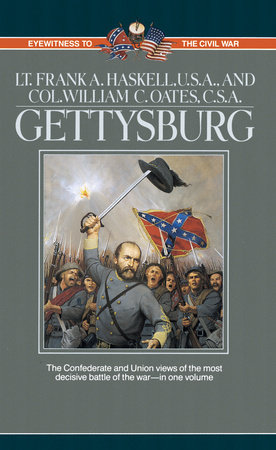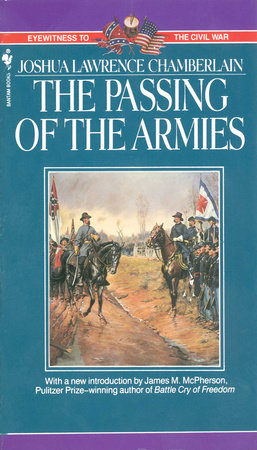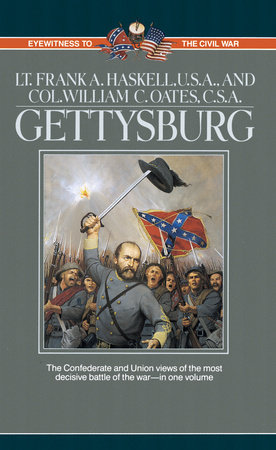Excerpt
Gettysburg
INTRODUCTION
by Glenn LaFantasie
No ONE will ever write a complete history of the battle of Gettysburg. So predicted Frank A. Haskell, a resourceful and stouthearted Wisconsin lieutenant who participated in the battle as an aide to Union General John Gibbon and who wrote his own account of what he had seen. According to Haskell, the story of Gettysburg could not be adequately captured in words. “Who could sketch the changes, the constant shifting, of the bloody panorama?” he asked. Even those who had experienced the battle firsthand could not do it justice. Soldiers in the combat, Haskell said, would be limited by their own “literary infirmity” and by “their not seeing themselves … as others would have seen them.”
Haskell’s opinion was echoed by another veteran of the battle, Colonel William C. Oates, the tough and dauntless commander of the 15th Alabama Infantry at Gettysburg. “No two men,” Oates wrote in the preface to his memoirs, which he composed late in life as a history of the War Between the States, “can participate in a great battle and see it just alike.” Anticipating that critics of his narrative would be severe in their attacks, Oates pleaded for fair treatment but stated his own defense before the fact: “I have ideas of my own and can recognize the truth when I see it, and usually have the courage to express it in a respectful manner whenever it is pertinent to the question in hand.” But he emphasized that “it is human to err.” In a letter written long after the battle to Joshua Chamberlain, the man who had led the Union regiment that repulsed the 15th Alabama at Gettysburg, Oates reiterated that “No one man can see all that occurs in a fight, even between regiments.”
Like so many other Americans of the Civil War generation, these two seasoned officers believed that no one could ever accurately describe the war or its battles in words. Walt Whitman, who saw the gruesome effects of the Civil War while working as a hospital attendant in Washington, agreed: “Future years will never know the seething hell and the black infernal background of countless minor scenes and interiors (not the official surface courteousness of the generals, not the few great battles) of the Secession War; and it is best they should not. The real war will never get in the books.” Later generations, who were fairly inundated by the ocean of Civil War writings—memoirs, reminiscences, letters, histories, and novels—that continued to be published after most of the veterans had passed quietly away, reached the same gloomy conclusion. Trying to grasp the significance of the war and the experiences of the soldiers who fought it, Sherwood Anderson, the famous novelist, could not overcome his own frustration with the elusiveness of its reality and substance. “No real sense of it,” he declared, “has yet crept into the pages of a printed book.”
If we accept these statements at face value, including the ones made by Oates and Haskell, we must suppose that no account of Gettysburg, even those written by men who stood in the thick of the fighting, can adequately tell us what this battle was like or how the soldiers, Union and Confederate, who clashed in the July heat of 1863 must have felt as they stumbled up the steep and rocky slopes of Little Round Top or ran for cover as shells burst around them during the most furious cannonade ever to take place in North America. We must assume, from what Oates and Haskell assert so forcefully and from what many critics and writers have since pronounced as authoritatively, that the battle of Gettysburg will always remain unknown and unknowable.
But the narratives of Colonel Oates and Lieutenant Haskell, like hundreds of other firsthand accounts written by Gettysburg veterans after the battle was over, actually belie this supposition. It is from their accounts, from the rich and plentiful array of evocative eyewitness reports, that we may indeed gain a realistic sense of what this supreme battle of the Civil War, a battle that marked the turning point of the conflict between the North and the South, must have looked like and sounded like in all its fury, horror, and glory. It is from these accounts that we can, by using our historical imagination, transport ourselves back in time more than one hundred twenty-five years to stand shoulder-to-shoulder in the long gray lines of General Robert E. Lee atop the wooded crest of Seminary Ridge or to kneel with blue-clad comrades firmly clutching their muskets behind the low stone wall on Cemetery Ridge.
The power of words did not fail Oates and Haskell as much as they had assumed or feared. Ever since their narratives of Gettysburg were first published, they have been ranked by students of the battle as classic accounts. No historian would dare write about Longstreet’s assault on the afternoon of July 2 without first consulting Oates’s lively testimony; likewise, scholars and other writers have relied heavily on Haskell’s extensive and dramatic account of the Federal repulse of Pickett’s Charge on July 3. Of the two, Haskell’s discourse is the more famous, and deservedly so; his felicitous (though sometimes florid) use of language, particularly his flair for metaphor, reveals his special talents as an alert observer and a skillful writer. Haskell’s account of Gettysburg is regarded not only as a useful and informative historical source but also as a minor masterpiece in the literature of the Civil War. In comparison, Oates’s workmanlike prose, especially when he writes about events he did not personally witness, often falls flat in its sparseness and straightforward simplicity. Differences aside, however, the fact remains that these two tellings of the Gettysburg story are remarkable first-person accounts that have long been valued and praised for their perspicuity and verisimilitude.
If we seek today to know something more about Gettysburg than the strategy and tactics employed by the generals, something beyond the impersonal engagement of armies that move on chessboard fields, something more closely connected to the men who faced the volleys of minié balls and grapeshot, we must first attempt to overcome the distance that separates our modern sensibilities from the lives of the soldiers who marched and fought and died at Gettysburg. The chronicles of Oates and Haskell help us to bridge the gap between the present and the past. Reading their accounts, we see events unfold before us through their eyes. We are taken back to the fields and hills of Gettysburg to see the action as it occurs, with Oates and Haskell as our trusted guides.
Obviously what we experience in reading these accounts cannot compare with the human ordeal that men like Oates and Haskell actually endured in the front lines at Gettysburg. We cannot pretend to ourselves that reading about a battle is anything at all like living through it. Nor do we, in reading these accounts, necessarily see the battle in all its terrible wholeness or complexity, for the eyewitness reports of Oates and Haskell are circumscribed, just as they suspected they would be, by the limits of their own position on the battlefield—a phenomenon called “the fog of war” that happens to every soldier in every battle. No one engaged in combat ever knows what is precisely going on beyond the smoke of battle that engulfs him. His range of understanding is necessarily narrowed to events that occur around him, within his immediate line of vision, or to his own personal experiences on the battlefield. Haskell, knowing full well how severely his own perspective was restricted and even obstructed, explained that his narrative was “not designed to be a history, but simply my account.”
But if our national fascination with Gettysburg—indeed, with the Civil War in general—is in fact motivated by a desire to know what it was all about and what the soldiers thought and felt and did as they were swept up into this colossal conflict of arms, these accounts are surely a good place to begin. Reading these personal annals, written by two accomplished officers who survived some of the worst and bloodiest fighting at Gettysburg, we come as close as we can get to touching their world and understanding what this battle meant to them.






